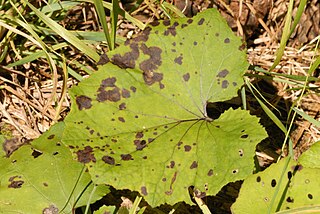
Viola canina, commonly known as heath dog-violet and heath violet, is a species of the flowering plant in the violet family Violaceae. It is native to Europe, where it is found in heaths, fens, and moist woodlands, especially on acidic soils.

Alchemilla alpina, commonly known as alpine lady's-mantle, is an arctic-montane herbaceous perennial plant native to Europe and Southern Greenland.
Ramularia beticola is a fungal plant pathogen infecting beets.

Ramularia brunnea is a fungal plant pathogen infecting strawberries. It was first described scientifically by American mycologist Charles Horton Peck.
Ramularia cyclaminicola is a species of fungus in the family Mycosphaerellaceae. It is a plant pathogen that infects cyclamens.
Ramularia macrospora is a fungal plant pathogen infecting bellflowers.
Ramularia menthicola is a species of fungus in the family Mycosphaerellaceae. It is a plant pathogen that infects mint. It was formally described as a new species by the Italian mycologist Pier Andrea Saccardo in 1886. In his 1998 monograph on phytopathogenic Hyphomycetes, Uwe Braun suggests that Ramularia menthae should be considered a synonym to Ramularia lamii, but the name remains in use in the scientific literature, and is accepted as a valid species by Index Fungorum.
Ramularia necator is a fungal plant pathogen infecting coconut palms.

Ramularia primulae is a fungal plant pathogen infecting Primula. Its primary host is Primula veris.
Ramularia spinaciae is a fungal plant pathogen infecting spinach.

Mycosphaerella is a genus of ascomycota. With more than 10,000 species, it is the largest genus of plant pathogen fungi.

Ramularia is a genus of ascomycete fungi. Its species, which are anamorphs of the genus Mycosphaerella, are plant pathogens. Economically important host species include Narcissus, sugar beet, and barley.
Ramularia subtilis is a fungus.
Ramularia tenella is a fungus.

Cercosporella is a fungus genus in the family Mycosphaerellaceae.
Ramularia vallisumbrosae is a fungal plant pathogen infecting daffodils (Narcissus), causing narcissus white mould disease.

Ramularia rubella is a plant pathogen in Ascomycota that infects Rumex species. Infection produces reddish spots on leaves. The red color is caused by the production of rubellin, a photodynamic anthraquinone-derived phytotoxin. R. rubella was originally described from Rumex aquaticus in Germany; it has a wide geographic range on Rumex species. It is being investigated as a biological control agent of Rumex obtusifolius.

Ramularia ulmariae is a fungal species described by Cooke in 1876. Ramularia ulmariae belongs to the genus Ramularia and the family Mycosphaerellaceae. No subspecies are listed in the Catalog of Life.

Rubellin B is a phytotoxic chemical responsible for the Ramularia leaf spot disease due to its ability to create reactive radical superoxides. The drug has not been involved in many clinical studies, but has been found to prevent tau aggregation pointing to its potential in the treatment of Alzheimer's disease.








